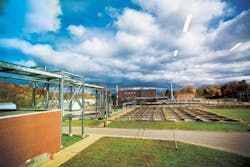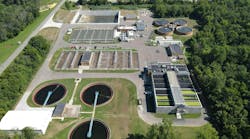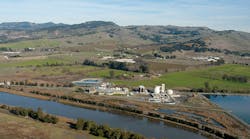Treatment plants by nature are service facilities, built to turn waste into something that can be safely returned to the natural environment or reused. The Greenway plant in London, Ontario, Canada, is that and more—in addition to being a fully operational wastewater treatment plant, it also functions as a demonstration facility for technology testing, allowing companies to develop and prove new approaches to water and wastewater treatment and management.
The Greenway Plant
The plant itself has a capacity of 152 million liters per day (mld), with an 18-mld expansion planned for fall 2015. It serves a population of 240,000, with treatment on the site dating back to 1900s-era septic beds. Two expansions over the years bumped up capacity; a 1964 expansion doubled the size of the plant with the addition of a third activated sludge section, and a 1996 expansion added supplemental aeration tank capacity and new final clarifiers. Ultraviolet disinfection was installed in 1998 to meet strict chlorine limits in the plant effluent.
The plant also has modernized its monitoring technologies, which has had positive results, according to Geordie Gauld, division manager of wastewater treatment operations.
“Automation and online instrumentation have been used to improve the performance of the plant while giving operations staff current information and critical operations parameters,” Gauld said. “Primary sludge pumping rates are controlled through sludge density meters, and raw and dewatered sludges are also monitored online.”
Challenges & Opportunities
Like all plants, Greenway faces challenges. The city of London and its park system have expanded around the plant, so any expansions and upgrades must be completed within the existing fence line. This caused the plant to switch from space-wasting lagoons to a new technology—geotextile bags—to dewater ash, according to Gauld.
Sludge generated at five London plants is trucked to Greenway, where it is mixed with the Greenway sludge in holding tanks and then incinerated. The ash formerly was kept in the lagoons and then transported off site, which was costly and labor-intensive.
The facility now uses geotextile bags to manage its ash waste stream. The bags fill with dredged waste and excess water drains out, often of high enough quality that it can be reused or returned for processing or to native waterways without additional treatment. The filtrate then is transferred to a lift station and pumped back into the treatment process at the plant for further treatment prior to discharge. The city has arranged for the dewatered material to be used as an aggregate for concrete, keeping it out of landfills, and the space saved allowed the plant to add other infrastructure.
“Upgrading the ash dewatering system from lagoons to the geotextile bags opened up considerable space for the construction of new secondary clarifiers and reconfiguration of the existing aeration tanks,” Gauld said.
Future challenges will include refurbishing the aging infrastructure while ensuring the plant remains in compliance with its effluent criteria. The city of London will be looking at optimizing the capacity of all of its plants in conjunction with capacity expansions, refurbishment and flood proofing over next few years, according to Gauld. Greenway’s planned expansion will include split-flow chemically enhanced primary treatment to improve the wet weather capacity and performance of the plant. This expansion also will include 7 mld for storage of wet weather flows through repurposing of existing tanks.
The Plant & Demonstration Facility
The Greenway plant is unique in its connection to a demonstration facility. This facility is part of the Southern Ontario Water Consortium (SOWC), which includes nine post-secondary institutions and facilities designed for real-world demonstration of water technologies. In addition to the Greenway wastewater plant and another in Guelph, Ontario, there are instrumented watersheds with real-time monitoring connected to a data platform for testing sensors or developing remote sensing or modeling systems. There also is capacity for mobile or in-situ testing of drinking water treatment technologies, mobile labs for evaluating the effects on fish and invertebrates, and a facility dedicated to developing and prototyping sensors.
“SOWC helps water companies access these facilities and connect with a critical mass of research expertise,” said Brenda Lucas, SOWC executive director.
Gauld said the Greenway plant allows for both wastewater treatment and research/demonstration: Up to 4,500 cu meters per day of process flows are recirculated from the field to the test facility, then returned to the point of origin; only one type of flow can be supplied to a test bay at a time. Tenants (entities using the space to test their technologies) can access all or a portion of the 4,500 cu meters in each of the four test bays. Primary and waste activated sludge also are available in two of the test bays, but at much lower volumes. Test flows are redirected back to the plant when testing is completed. One 60-amp, 600-V electrical receptacle is provided for each test bay in addition to four wall outlets per bay.
According to Lucas, one of the drivers for the cities of London and Guelph for working with SOWC to create these facilities was to allow companies to develop and demonstrate new approaches and technologies.
“There is an increasing willingness on the part of municipalities in Ontario to host pilot demonstrations, as London has done, and on the part of our regulatory agency to facilitate this,” Lucas said. “But with dedicated facilities, it becomes much easier for a company to prove that its technology is ready for that stage. There is no disruption to the operating plant and no need to work out any permits, which can be a challenge. It’s a ‘plug and play’ model.”
As regulations tighten, new water treatment technologies emerge and companies seek real-world means of testing and proving their solutions, the Greenway plant may become less of an outlier and more of a trendsetter.
Download: Here


